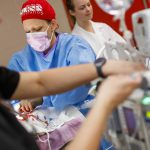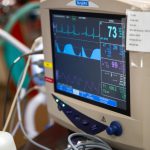Developing Lifesaving Treatment for Lung Injuries
A soldier suffering a traumatic lung injury on the front lines faces a life-threatening Catch-22. The brain and other organs continue to demand oxygen, but taxing the damaged lung exacerbates the injury.
Because soldiers are often far from full-fledged treatment, the situation is even direr.
Husker engineer Benjamin Terry and colleagues with the Nebraska Strategic Research Institute are working on potentially lifesaving solutions with support from a $3.7 million Department of Defense contract.
“The best way to heal a lung is to not use it,” said Terry, associate professor of mechanical and materials engineering. “But if you don’t have the function of your lungs, you die. How do you let the lung heal and still get oxygen to the patient?”

Terry, Keely Buesing of the University of Nebraska Medical Center and Mark Borden of the University of Colorado Boulder are answering that question using microscopic oxygen bubbles that mimic the role of the lungs’ alveoli, tiny air sacs that release oxygen and remove carbon dioxide. Placing these bubbles in the abdomen enables critical organs to continue working while affording crucial respite to the lungs.
The bubbles are delivered via a portable catheter, making it possible to use the technology in soldiers being transported from remote locations. To make the approach even more battlefield friendly, Terry is developing a device to ensure that field medics, who lack advanced surgical training, are able to place the catheter.
Terry’s is the only U.S. research group to use these oxygen bubbles in body cavities.

The method’s potential extends beyond defense applications, Terry said. He envisions it could someday treat all patients, from newborns to the elderly, who have severe, acute lung problems.
“For the past decade, there’s been a standstill in helping people with lung failure. This technology can break through that glass ceiling.”
A University Affiliated Research Center, NSRI was established in 2012 as a partnership between the University of Nebraska system and the DOD.
Additional content
Nebraska news release: DoD-funded microbubble tech to address lung injuries
